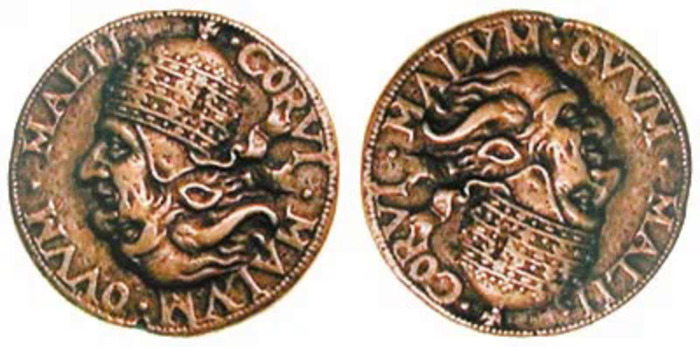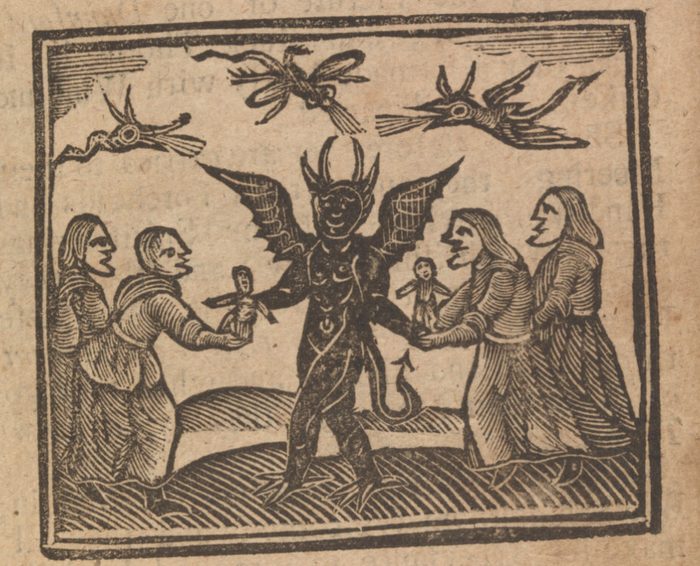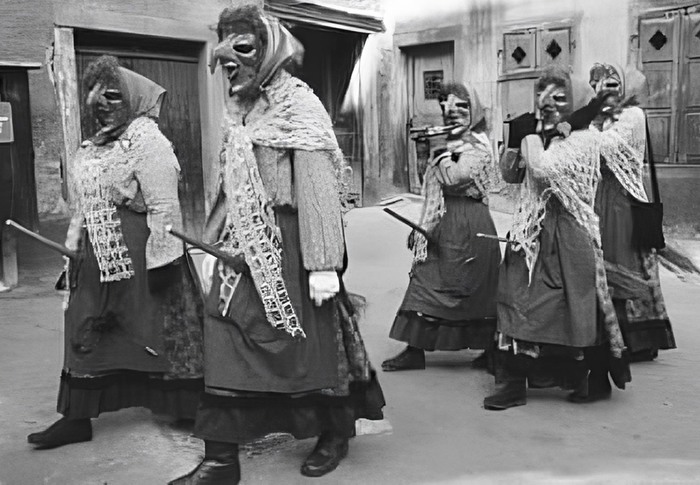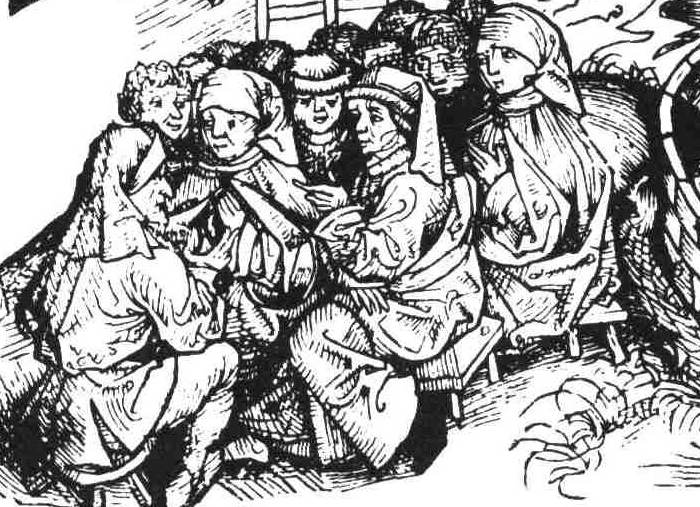Butchers' chins and noses get bigger the further back you go. Sat 29 May 2021

The big-nosed, big-chinned medieval butcher. Source
This Chalfont St Giles church wall-painting shows an execution at Herod's Feast. The executioner wields a sword in his right hand. The executioner seems to be wearing a distinctive long hood.
We've seen long, pointed hoods like this before - on dwarves, on witches, on Father Christmas and on Loki:
The hat, the nose. And the net. Source: Loki
And we've seen them on coins:
In this case, lampooning the Pope. Source: I.Grek Goddess Nessati or it all depends on the point of view
And we've seen long, pointed hoods on suppressed Cambridgeshire hill figures:

Magog chalk giant at Wandlebury hill, Cambridgeshire, c. 1978. Source: Secret of a Cambridgeshire Hillside
The Chalfont St Giles church wall painting allegedly shows the beheading of John the Baptist:
... his executioner, in the centre of the scene, is rather clearer. He has the grotesquely exaggerated facial features commonly found in paintings of the torture or execution of Christ and the saints, with a prominent nose and huge jutting chin.

Chalfont's big-nosed executioner. Source
Chalfont's big-nosed butcher is the vicar.
Europeans are more familiar with his female version - the wicca:
Tax Day. Source: The History of Witches and Wizards, 1720, p15
These big-chinned women are apparently not the children's mothers. They are the vicars. The wiccas. As in vicari. Farm managers.
Their prominent chins were well remembered for a while:
1899 witches' parade, Basel, Switzerland. Source: Shock of the old
Though these days we've forgotten their chins:

Witch celebration in the Harz, Germany. Source: Witch Kitsch and Dark History
Instead, we focus on her nose, her strange-coloured skin and her hat
For more memories of her - and her complexion - see Ice Age Sites of Britain's Serpents - Part Four.
A similarly big-nosed, big-chinned face briefs pilgrims on a medieval German farm:
Hans Böhm preaching. Source: Hans Böhm - Wikipedia
The image allegedly depicts the Drummer of Niklashausen - Hans Böhm. His is a variant of the Hansel and Gretel story: with divine help he escapes a cruel stepmother and then preaches against inequality. Hansel and Gretel escape a child-eating witch:
Facial features of the wicked witch. 1909. Source: Hansel and Gretel - Wikipedia
I'd argue the Hans Böhm image - but not the tale - shows a vicar briefing pilgrims - itinerant carcass processors - outside a moated manor. Itinerant carcass processors as in hair and skin harvesters. And as in 'gypsies' - gypsum collectors and bone processors. You will see more evidence for big-chinned skulls a little further on.
The tale of Hans Böhm - and of Hansel and Gretel - positions events around a little ice age.
From Peasant Fires: The Drummer of Niklashausen, Richard Wunderli, 1992:
God and her Son were angry with mankind and were chastising all peoples with the dreadful cold and snow.
Modern versions of both tales - actually humanity's tale - skip the chins, the noses and the hats.
But not the cannibalism and the babies:
Nutritionists call that 'mouth feel'. Source: Snowpiercer, 2013
It's their inexplicably high fat content
Human babies carry about 15% fat at birth. Our nearest primate relatives carry 2-3%. Only one other mammal comes close to us. Arctic seal pups carry about as much fat as us. For them, the reason is obvious. For human babies, it isn't. Unless you accept that human babies were designed as nourish Little Ice Age diners.
As genetically engineered 'grub':
They feed us to ourselves. Source: Cloud Atlas, 2012
The Chalfont butcher's nose is apparently no exaggeration. Nor it is it unique to a single Buckinghamshire church:
Graffiti at St Mary the Virgin, Stone, Kent. Source: Raking Light
And in north America:

The Birdman Tablet, Cahokia, Illinois. Source: Illinois State Museum
In Mounds for the Dead - An Analysis of the Adena Culture, 1 author Don Dragoo says most of north America's Adena tribe were short. But the tribe also had some taller than average elite members. These taller people had distinctive skulls.
Quoting Dragoo from Giants and Ancient North American Warfare: 2
Two outstanding traits have been noted repeatedly for this group. One is the protruding and massive chin often with prominent bilateral protrusions (The Adena People, Webb and Snow, 1959, p. 37). The second trait is the large size of many of the males and some of the females. A male of six feet was common and some individuals approaching seven feet in height have been found...
Webb and Snow suggested the possibility of "sexual and social selection" being factors in the development of the large-chinned Adena type.
selective breeding would be assiduously practiced, and for several good reasons. The main purpose could have been the creation of a guardian or warrior class made up of physically superior men and women.
Dragoo's quote is illustrated with these two skulls:

Big-chinned giant skulls from America. Source: Giants and Ancient North American Warfare
The image presumably came from The Adena People, Webb and Snow, 1974.
Roman coins reveal the same two facial characteristics:
Roman emperor Vespasian. Source
It would be easier to engrave this coin without the protruding chin. Yet the effort was made.
Let's take a look at 18th century touring writer John Byng. In 1954 we were told Byng looked like this:

John Byng as his 1954 editors wanted us to see him. Source
And earlier, that he looked like this:

'Byng Lord Torrington' by engraver: 'Aveline'. Source
But cartoonist Thomas Rowlandson - apparently caricaturing him as 'Dr Syntax' - portrayed Byng like this:
Note that extended cranium under the peri-wig. Source
Byng's role was military or proto-military. Most of his tours were written while working for Colonel Bertie (possibly Brownlow Bertie, 5th Duke of Ancaster). In The Torrington Diaries, he refers to scouring eastern England's destroyed churches and associated villages for stained glass and metals:
Hangar 1 for Antiquitech 101. Source: Fallout
Byng also refers to his being able to speak German, writing that it was an advantage when he fought in Germany. What we might call 'the Holy Roman Empire'.
Byng also inspects, assesses, and frequently comments on 'the guard' or 'the guardsmen' of the towns he visits.
Long chins and long noses also feature in older images of town guards:
The Old Town Guard, Edinburgh. Source: Reminiscences of Old Edinburgh, Vol II
From Reminiscences of Old Edinburgh, Vol II:
Vignette is based on a sketch by the late Charles Kirkpatrick Sharpe.
From Charles_Kirkpatrick_Sharpe:
In drawing, Sharpe's strength was satirical or grotesque caricature. His frontispieces and illustrations in the Bannatyne Club and other antiquarian publications applied antiquarian knowledge
'Antiquarian knowledge'?
Of what?
Of how they looked. The pigtails suggest they are 'blemiye' overseers:

Blemiye harvest-guards on a misericord. Source
Also by John Kay:
Three noses, two chins. 1784. Source A series of original portraits and caricature etchings
Alexander Kinnaird was the last laird of Culbin, in Scotland. The last laird because Culbin drowned beneath an enigmatic sand patch. It was about where Findhorn is today. See Desert Islands of Eastern England.
A portrait of Kinnaird shows him playing cards with a long-nosed, long-chinned entity usually described as the Devil:
Devil on the left; Laird of Culbin on the right. Source
For more on the terraforming capabilities of Britain's big-nosed, big-chinned teknoi, see Ice Age Sites of Britain's Serpents - Part Four.
Chalfont St Giles, Buckhinghamshire and Wandlesbury, Cambridgeshire
© All rights reserved. The original author retains ownership and rights.
-
Archive.org marks Mounds for the Dead - An Analysis of the Adena Culture as 'borrow-only' despite its 1963 publication date. This may indicate digital censorship, forgery or reader-tracking. ↩
-
I wouldn't usually quote Bibliotecapleyades but we can compare its claims with evidence from elsewhere. Oddly, despite being old, several of the books it quotes from are access-restricted to 'borrow-only', which forces traceability of readers. This may be related to Bibliotecapleyades being hosted by spooks. ↩
More of this investigation:
Evidence of Giants
More by tag:
#giants











